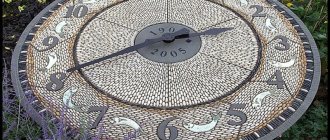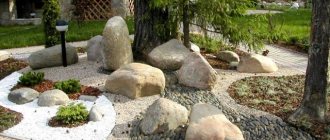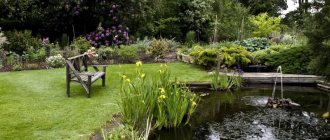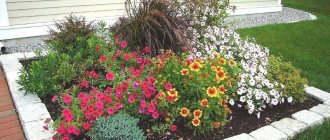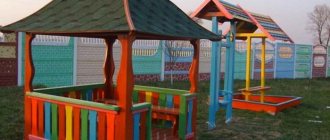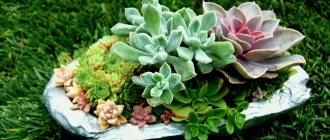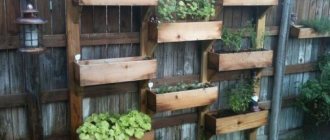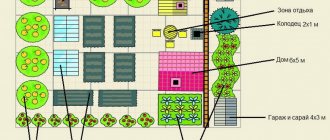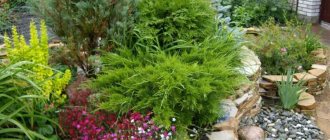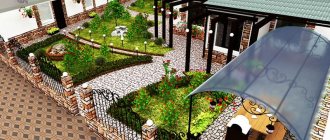What are pebbles
Pebbles are a natural stone characterized by a rounded shape with bulges and depressions. It looks like a flattened round or oval stone.
Colors can be different: gray, white, black, brown and others. Artificial specimens can be given any color using coloring pigments. The sizes are often small (about the size of a chicken egg or smaller), but can reach 7–10 cm.
Pebble is a loose rock of sedimentary origin, consisting mostly of pebbles with a small amount of sand, clay, and silt.
View this post on Instagram
Posted by Green Stone Perm (@zelenii_kamen_perm) Jun 30, 2019 at 3:13 PDT
How is it different from gravel and crushed stone?
If you compare it with gravel and crushed stone, there will be some differences in external characteristics and areas of application.
Pebbles are smooth, homogeneous in composition, with a smooth shape, and are of river or sea origin. Gravel has a heterogeneous composition, including several rocks and mineral impurities, has a somewhat rough surface, and is mined in quarries.
In fact, gravel and pebbles are the same thing, they just have different places of extraction.
Crushed stone is a material created by crushing rocks that has sharp edges and roughness.
The first two options are used primarily for decorative purposes, as they have a beautiful appearance. And the latter is for construction, because it fills voids well, interacts with concrete, sand, etc.
Pebbles in the living room
However, the bathroom is far from the only room where this natural material can be used. For example, the living room interior with pebbles looks very stylish and unusual. If your living room has arches or niches, decorate the inside of these objects with pebbles. This simple decoration will add a bright color to the Mediterranean, marine or eco-style. You can also use pebbles to cover the frame of a fireplace or decorate the surface of a table or bedside table.
Living room interior with pebbles
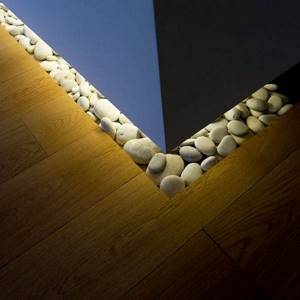
Pebbles in the interior photo
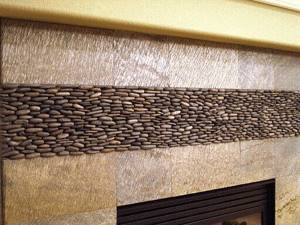
Fireplace decor with pebbles
Origin of the stone
Natural stone, river or sea pebbles, is formed naturally under the influence of wind and water. The rock is washed by water for years, blown by air currents, plus pebbles roll against each other. This is how nature creates a small stone with rounded edges.
Artificial imitation is created during mechanical processing of rocks.
They are crushed, and the fragments remain as they are (crushed stone) or are polished, sanded, or painted to improve their decorative characteristics.
Watch the video on how to mine stones yourself:
Physico-chemical composition and color
Each classification includes a division of stones and minerals by origin. There are organic, endogenous, exogenous and metamorphic formations. They differ from each other in composition, density, shades, formation period and other characteristics.
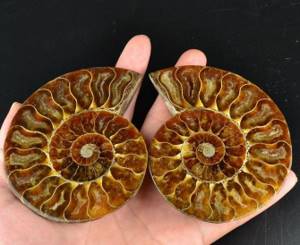
Ammonite
Organic rocks include fossils of various types that were once living organisms or that arose as a result of biological processes. Representatives of the group have the following names:
- ammonite;
- nacre;
- coral;
- pearl;
- amber;
- Ivory;
- jet;
- belemnite (or devil's finger);
- petrified wood.
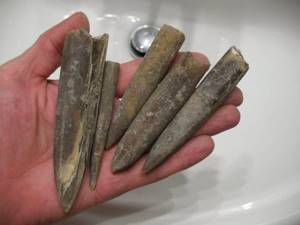
Belemnite
Each of them has a unique history of origin and properties. It took several millennia for some of the stones that were once part of the living world to form. However, many are able to form within 7–10 years.
The endogenous process takes place in the depths of the earth's surface. The stones are formed from a silicate fiery liquid melt called magma. There are many representatives of the group, but not everyone is used in jewelry. Often the choice of specialists falls on quartz, which is shown in the photo. It is distinguished by its hardness, resistance to water and alkalis.
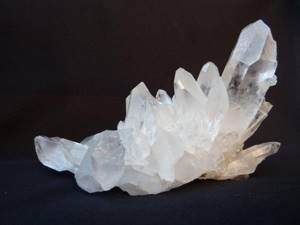
Quartz
An exogenous process is characteristic of the surface of the earth's crust; rocks are mined on land and in the sea. For the formation of crystals, weathering is necessary, after which several groups appear at once: hydromica, kaolinite, halite, opal, sylvite. Some are the result of the vital activity of marine life and plant organisms. All exogenous formations have properties different from other minerals. They are relatively soft and do not tolerate contact with water and acids.
The formation of metamorphic types of minerals occurs under the influence of certain factors in the earth's crust. Some require high temperatures and pressure changes, others require magmatic gases or water. To begin the process, previously formed exogenous samples are required. As a result of metamorphic formation, minerals become stronger and acquire high density.
Natural stone, river or sea pebbles, is formed naturally under the influence of wind and water. The rock is washed by water for years, blown by air currents, plus pebbles roll against each other. This is how nature creates a small stone with rounded edges.
Artificial imitation is created during mechanical processing of rocks.
They are crushed, and the fragments remain as they are (crushed stone) or are polished, sanded, or painted to improve their decorative characteristics.
Pebbles are rocks that are predominantly sedimentary or igneous in origin. It comes in different colors, the most common colors are gray, blue-gray, lead, blue, white, red. There are variegated pebbles that are formed by several rocks. The shape is most often ellipsoidal, oval, ovoid.
Physico-chemical properties of pebbles:
- density - 2500-2700 kg/m3, depends on the forming rock;
- frost resistance - F150-F300;
- water absorption - 0.2-0.6% of the total mass;
- sizes - 1-15 cm.
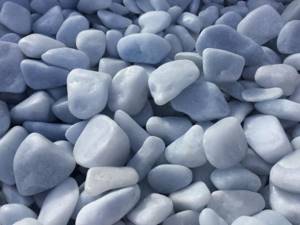
come in yellow, white, blue, brown, and brown colors. Properties of pumice:
- porosity - 80%;
- hardness on the Mohs scale - 6;
- density - 2000-2500 kg/m3.
Types of pebbles
There are several varieties that differ in external characteristics, composition, and place of extraction. Each of them has its own characteristics and advantages, which determines the scope of application.
Varieties:
- Marble. Tumbled marble pebbles are popular in landscape design. It is created from waste that remains when working with marble. The shards are polished and ground, resulting in a rounded shape with smooth surfaces.
- White. Natural stones collected near mountain rivers and foothills. Used to decorate garden paths, artificial ponds, and shop windows.
- Gray. Glossy small stones. Used for finishing baths, saunas, bathrooms.
- Black. Made from marble and dolomite, polished and coated with a compound to create a glossy shine. Black pebbles are resistant to low temperatures, humidity, and damage.
- Marine. Collected on sea coasts, washed to remove dirt and salts, and used in design. The marine variety is used to decorate elements on a personal plot, zone walls, and decorate floors.
- River. Pebbles created by nature from quartz and granite. Can be white, gray, black, tri-color. Used for landscape decoration.
- Caspian. A flat variety formed from sedimentary rocks on the shores of the Caspian Sea. Has a white or brown color. Used for decorative purposes.
- Chernomorskaya. Black Sea pebbles are predominantly gray in color and round. Used for landscaping. Gathered on the shores of the Black Sea.
- Granite. It is made of granite, famous for its particularly strong properties and resistance to temperature changes. Used for indoor and outdoor home improvement.
- Silicon. It is used for water purification in natural and artificial reservoirs (see stones for water purification in a well), because it sorbs chemicals well and disinfects.
- Glass. Made from glass fragments, painted to improve decorative properties. The glass variety is quite durable and is used to decorate bathrooms, frames, mirrors, create crafts and decorations.
- Washed. This look is obtained when pebbles are freed from foreign impurities. Washed pebbles are more convenient to use and are easier to “grab” with adhesives.
- Colored. An artificial variety used to decorate a personal plot. The workpiece is painted with a special paint. This contributes to resistance to high and low temperatures and fading.
- Decorative. An artificial variety used to decorate the house inside, outside and to decorate the local area. Stones can be given any size, shape, color. They are made from gypsum, slate, granite or marble chips.
The division into small and large pebbles occurs according to size. Origin: sea or river. Small pebbles are often used for crafts and site decoration. Large ones - for finishing garden paths, artificial ponds, floors.
See photo gallery of the stone:
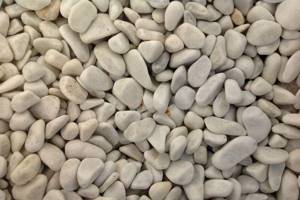
marble pebbles
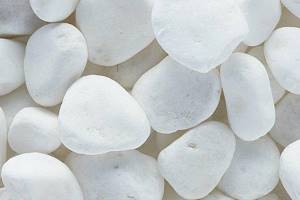
White pebbles
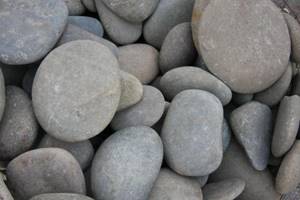
Gray pebbles
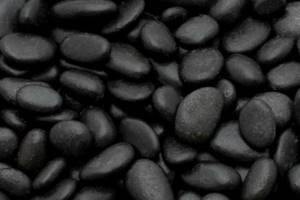
Black pebbles
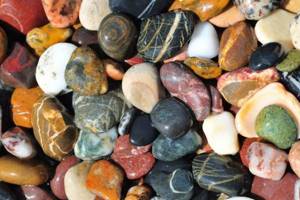
sea pebbles
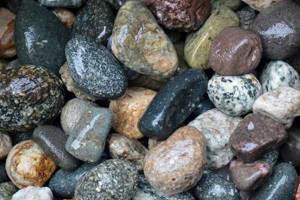
river pebbles
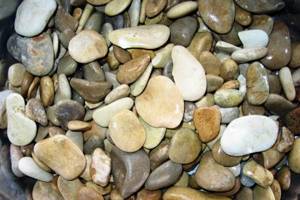
Caspian pebbles

Glass pebbles
Types of sea stones
Those pebbles that we all love to play with on the beach are real rocks, witnesses to prehistoric times. Light porous pumice is the remains of petrified volcanic magma, frozen far from the eruption site and picked up air - hence the numerous pores. The names of sea stones that are smoother and heavier are basalts and tuffs. They were formed when lava came out of a volcano. And the heaviest sea stone - granite - originated in its very crater.
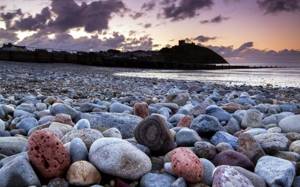
The shiny, egg-shaped, rounded granite blocks we see on the beach are a durable and shiny (thanks to a mixture of mica, quartz and feldspar) example of volcanic rock. Monuments and obelisks are erected from it, and it is in demand by builders and designers. Other finishing stones - basalts, tuffs of different shades - are excellent for facing surfaces. Almost any sea stone can be used for applied or decorative purposes.
On the beach you can also find samples of semi-precious minerals - syenites, porphyrites, chrysolites. These beautiful sea stones are used to create jewelry and costume jewelry. The favorite of healers, chalcedony, is also found there. Even more ancient than rocks, these stones also come from volcanic craters.
Technical characteristics and stone density
The mineral composition of pebbles can be different, since they are formed from different rocks:
- marble;
- granite;
- slate;
- quartzite;
- mica;
- feldspar;
- gypsum;
- sandstone
Main characteristics:
- Dimensions – from 0.5–10 cm.
- Density (specific gravity) – 2550–2670 kg/m3.
- Service life is not limited.
- Environmentally friendly - does not contain harmful substances.
- Hygroscopic - does not allow water to pass through, dries quickly.
- Resistance to environmental influences is good.
River and sea stones used for decorative or construction purposes must comply with GOST.
View this post on Instagram
Publication from I walk around the village on ? V ? (@olessya5) Jun 12, 2021 at 9:30 am PDT
Lots of ideas for useful little things made from pebbles
Probably, just as appetite comes with eating, it is easier to realize our creative ideas, starting with small forms, gradually moving towards more ambitious projects. And now you will see how many things can be built from flat river pebbles to decorate and furnish a country house interior.
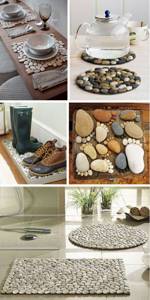
Simple and at the same time original coasters for cutlery and hot items, rugs for the hallway and bathroom, photo frames, flower pots and nice three-dimensional paintings-panels for decorating the home interior - this is not a complete list where the use of river pebbles occupies a leading position.
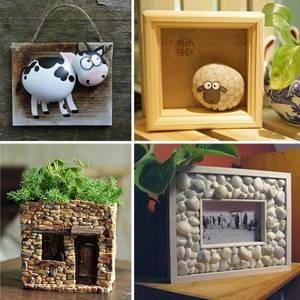
To make rugs, you can use a rubberized base or carpet scraps, on which the stone inlay will be attached using silicone glue. A shallow plastic tray filled with a scattering of pebbles is very convenient to keep in the hallway in case of rainy and slushy weather. It will quickly dry wet shoes without leaving dirty marks on a dry and clean floor.
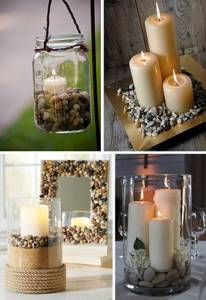
Another cute craft idea is pebble candle holders. You can simply pour it into a glass jar, immerse a thick candle in it, and an impromptu lamp for the porch or evening tea party on the veranda is ready.
Beautiful and romantic compositions with candles against a background of pebbles will effectively complement the festive table setting and create a special mood, rest assured. There is nothing complicated here at all, just show your taste and imagination using the most ordinary things: a glass cylindrical vase or a brass tray.
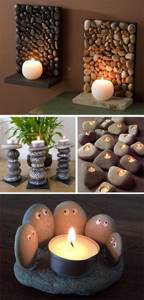
Or you can get a little clever with the design and make candelabra, miniature consoles inlaid with small pebbles, or this funny candlestick with big-eyed stones that literally come to life in the candle flame.
To create homemade mini rockeries with succulents, you certainly can’t do without small textured pebbles. The transparent glass shell allows you to thoroughly enjoy the live picture, and it doesn’t matter at all what exactly you choose as a vessel - an ordinary jar, a light bulb or a mini aquarium.
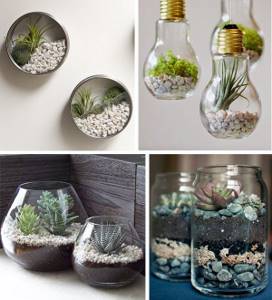
Pleasant to the touch, flat river pebbles can be used to decorate all kinds of household utensils, old furniture, flower pots and large flowerpots, which will look great in the front area of a country house. And a table lamp with a lampshade in a fashionable eco-style made of large pebbles is ready to become an original decoration for your bedside table.
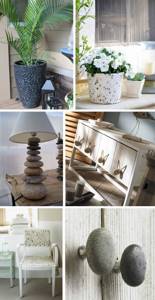
All we have to do is stock up on a sufficient number of suitable stones and begin exciting handicrafts. We really hope that our next retrospective of dacha ideas, brilliant in their simplicity, will not leave you indifferent. Write to us and share your successes, see you soon!
Tatyana Soboleva
Where is the stone used?
Pebbles are popular for landscaping, especially white or colored ones. They decorate it with:
- paths on the site;
- steps;
- flower beds;
- pools, wells, ponds;
- create rock gardens.
Decorative varieties are used to decorate the interior of the house:
- finishing walls, floors;
- kitchen apron lining;
- fireplace decor;
- as a tray for a shower stall;
- in a bath or sauna.
Can be used to create original decorative elements:
- furniture handles;
- decor of frames, paintings, panels;
- candlesticks;
- vases decorated with pebbles;
- hot coasters;
- rugs;
- decoration of flower pots;
- crafts.
View this post on Instagram
Posted by Anastasia (@anastasiia_1985) Apr 7, 2021 at 4:02 PDT
View this post on Instagram
Publication from World of Stone Samara (@mir_kamnja_samara) June 28, 2019 at 9:49 PDT
To view a simple DIY how to make a stone rug:
Glowing pebbles
An unusual option for decoration is artificial glowing pebbles. It is made of polymer plastic materials, which contain luminosity catalysts.
Outwardly it resembles natural, but weighs noticeably less. The ability to glow in the dark is due to the fact that the product first accumulates light and then releases it. That is, it turns out that the luminous analogues need to be “recharged”. The service life and number of “charges” are not limited.
A luminous imitation of natural stone looks impressive when decorating:
- local area;
- picture frames;
- finishing tiles;
- canvases for decorating walls in an apartment;
- jewelry;
- key rings;
- aquarium;
- vase
Video on the topic:
Sea pebbles in the bathroom interior
Most often, pebbles are used in the interior of the bathroom. In this room, the symbol of the sea coast looks most harmonious and appropriate. In addition, like any stone, pebbles are ideal for decorating rooms with high humidity.
It was once extremely fashionable to use pebble-effect tiles in the bathroom, creating a variety of nautical interiors. This tile is made from both decorative and sea or river pebbles. As a rule, pebbles are glued to a mesh or substrate, and then covered with a special grout, creating a single stone sheet. You can make similar tiles yourself. To do this, you need to purchase or collect a sufficient amount of pebbles, buy glue suitable for stone, mesh and grout. To make the process of creating tiles easier, you can purchase ready-made pebbles on a grid. This mesh will only need to be glued to the walls or floor, and then treated with grout and the pebbles cleaned. By making pebble tiles with your own hands, you can use them not only as a finishing material, but also as a decorative element. For example, similar tiles can be used to decorate the frame of a bathtub, the podium of a sink, or areas near the taps.
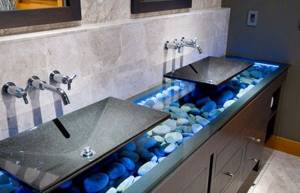
Pebbles in the bathroom interior
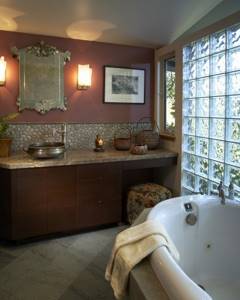
Pebbles in the bathroom interior
It is also very popular to cover walls with pebbles or use this material to decorate the floor. To cover walls or floors, it is not at all necessary to glue pebbles onto a mesh or backing. If your renovation is at the stage of plastering the walls, add a little green or blue color to the plaster. After applying the plaster to the wall, level it using a texture roller and, without waiting for it to dry, begin applying the pebbles, pressing them slightly into the mortar. Pebbles can be applied either in a chaotic manner or by creating specific patterns, mosaics or paintings from it. To make the pebbles look more attractive, you can treat their surface with varnish.
Yandex.Direct
| Aprons −70% Aprons at a super price! The best brands on Westwing.ruwestwing.ru |
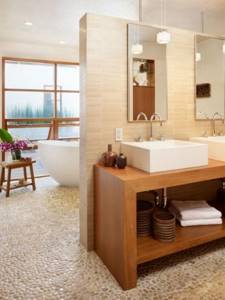
Pebbles for the bathroom floor photo
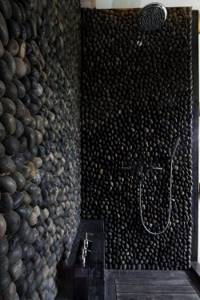
Pebble walls in the bathroom
DIY pebble floor
A bathroom floor laid with natural pebbles has a number of advantages:
- Easy installation;
- Individual result;
- Aesthetic appearance;
- Therapeutic effect.
The floor will require pebbles and a cement mixture as a base. First of all, it is necessary to dismantle the old covering and thoroughly clean the floor. The pebbles should be washed well and dried.
The cement mixture is prepared in parts according to the instructions. The base is poured and pebbles are immediately laid out on it. It can be laid out randomly or in the form of patterns. The pebbles should fit tightly together and be approximately the same size. Using this principle, the entire floor is covered.
The pebbles should be immersed in the solution more than halfway. Otherwise, the cleaning process will become more complicated, since some of the debris will fall under the surface of the stone. The best option would be to equip it with a “warm floor” system.
The video shows the features of paving floors using pebbles:
Interesting facts about stones
Inanimate nature has more than 4 thousand stones, the characteristics of minerals become more detailed. Unusual facts about them leave no one indifferent:
- the cat's gold pebble, shown in the photo below, can easily be confused with real gold in appearance, but it has no value;
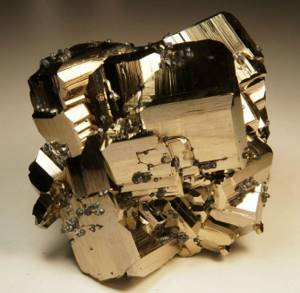
Pebble "cat's gold" (pyrite)
- in nature there are “watermelon” tourmaline minerals, which have a pink core and green edging;
- a diamond is so durable that it can scratch anything;
- crystal, citrine, morion, aventurine are the same stone called “quartz”, which has different luster and colors;
- to search for a 1-carat emerald, up to 20 tons of soil are processed;
- prices for precious gems are rising as there are fewer of them.
